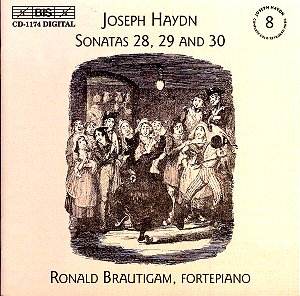Nobody knows how many keyboard sonatas Haydn wrote.
Some were lost during his lifetime and there are others that apparently
survived but are of doubtful attribution. There still remains a considerable
body of work written over a period of about a quarter of a century that
represents both a developmental stage in the sonata genre and a period
in which composers were adapting to the transition from harpsichord
and clavichord to piano.
The three sonatas on this disc are relatively early
works in the form for Haydn. They are from the same period - mid to
late 1760s - written when he was in his thirties at a time when he was
at his most experimental. Just as he was revolutionising the symphony
by expanding it in both size and emotional content, so also with the
keyboard sonata.
Two of the three works here, notably nos. 29 and 30,
represent a major step forward for Haydn and all three make a neat package
in the form of Brautigam's volume 8 in his noble enterprise of
recording all of Haydn's attributable keyboard music.
The sonatas are long for the time and in the case of
29 and 30 the slow middle movements particularly so, a practice clearly
deriving from 3 movement concerto form. Within the music there is more
than a hint of sturm und drang in some telling juxtaposition
of major and minor keys. A strong influence clearly comes from the sonatas
of Carl Philipp Emanuel Bach (Johann Sebastian’s second son). "I owe
a great deal to Bach", said Haydn. The sonatas of Bach he had been studying
shortly before writing these pieces were written well over twenty years
earlier which makes Haydn's work less ground breaking than posterity
has sometimes claimed.
C.P.E. Bach was still writing some great keyboard music
but, in my opinion, even his sonatas of the 1740s provide finer music
than that of Haydn's more than twenty years later. There are several
aspects of style that point to Bach, for example the free, toccata–like
passage in the first movement of no. 30 and an improvised cadenza in
the second. More importantly, what Haydn seems to be drawing on from
Bach is both passion and seriousness of intent, something unusual in
keyboard pieces of the period which were normally of the salon divertimenti
variety. But in expanding the sonata spatially, Haydn loses some of
the conciseness of C.P.E. Bach’s pieces which are much shorter. This
conciseness is one of the qualities that contributes to the intensity
of the latter’s music. But to be fair, Haydn’s more expansive classical
(and some would say South German) agenda is different.
The finest movement in these three sonatas is the first
of no. 30 in D major. It begins innocently enough but builds up an irresistible
power, partly through substantial development, something that, incidentally,
does not happen in the first movement of no. 29 which contains a lot
of exposition and little development. Brautigam is at his best here,
releasing the power through a steady, no nonsense approach without getting
carried away. His playing is mercifully free of mannerism and exudes
integrity. Although the music of these pre-1770s works, with its ornamentation,
gracings, baroque bass lines and so on, was almost certainly written
for the harpsichord and/or clavichord, Brautigam appears to be
intending to record all his volumes on the same instrument which is
a replica of a fortepiano, the original of which was made well over
thirty years after the pieces in this volume. So things are not quite
as authentic as they may at first seem. The booklet does discuss the
issue but rather defensively, suggesting it doesn’t matter. Well fair
enough. Fortepianos were around at the time and it is the persuasiveness
of the performance that counts. Brautigam certainly provides that although
some people may still prefer to return to that great advocate of Haydn’s
keyboard music, Alfred Brendel. Interpretatively the two are not dissimilar.
Some critics have enthused about the recorded sound
of Brautigam’s earlier volumes. The Swedish production
company, BIS, claims on its website that, "it seems to be generally
agreed, the Haydn series offers some of the best sound ever heard on
a fortepiano recording". I cannot altogether share the enthusiasm.
The fortepiano is recorded quite close and that, combined with more
than a hint of empty church hall ambience, makes the instrument sound
much bigger than it ought to, thus losing some of the sense of salon
intimacy that characterises much of the music. However, the instrument
is clearly a fine one so I would not want to suggest that this be a
major issue for potential purchasers. Here we have an enjoyable disc
of music that deserves to be better known.
John Leeman


